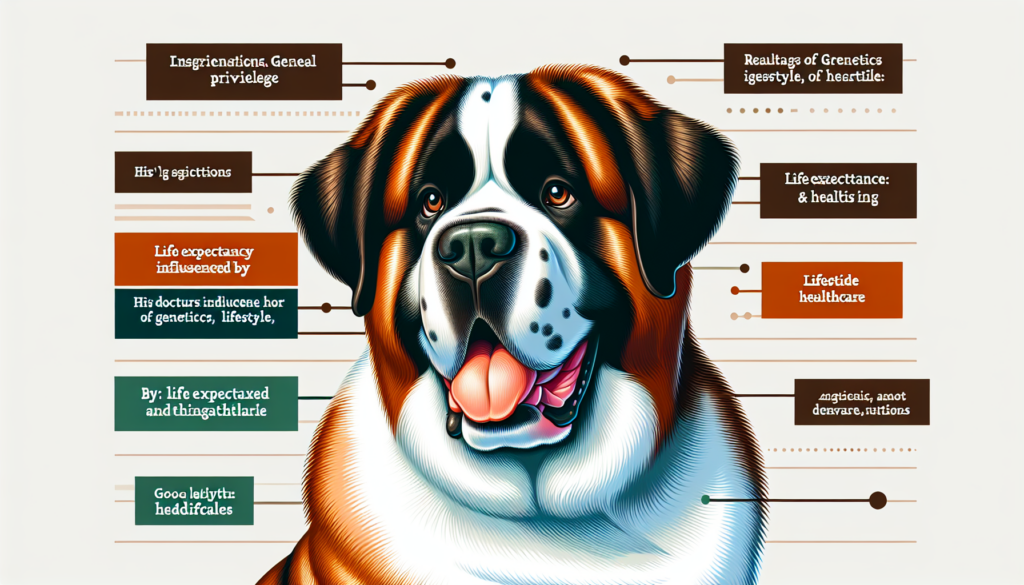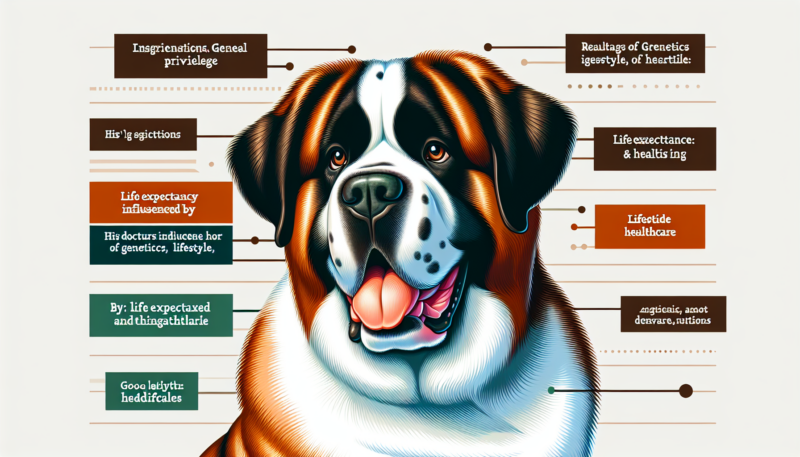Have you ever wondered what factors contribute to the life expectancy of a beloved Saint Bernard? These gentle giants are known for their imposing size and friendly nature, but how long can they expect to live? In this article, we will explore the various factors that influence the lifespan of a Saint Bernard, shedding light on their health, genetics, and lifestyle considerations. Whether you’re a proud owner or simply curious about these magnificent dogs, join us as we uncover the secrets behind their longevity. So, grab a cup of tea and prepare to dive into the fascinating world of Saint Bernard life expectancy.

Physical Characteristics
Size
The Saint Bernard is a large breed, known for its impressive size. On average, adult males can weigh between 140 to 180 pounds and stand 28 to 30 inches tall at the shoulder. Females are typically slightly smaller, with a weight range of 120 to 140 pounds and a height of 26 to 28 inches. This size can vary slightly based on genetics and individual factors.
Weight
Weight is an important aspect of a dog’s overall health, and it is crucial to maintain an appropriate weight for your Saint Bernard. Obesity can have a significant impact on their overall well-being and can increase the risk of various health issues. It is crucial to monitor their weight and consult with a veterinarian for guidance on a healthy weight range for your individual Saint Bernard.
Coat Length
The Saint Bernard is known for its beautiful and dense coat. They have two coat varieties: the smooth coat and the rough coat. The smooth coat is short and sleek, while the rough coat is medium to long in length and features a dense, water-resistant undercoat. Both coat types require regular grooming to keep them clean and free of tangles or mats. This can be done through regular brushing and occasional bathing.
Health Issues
While Saint Bernards are generally healthy dogs, they are prone to certain health issues. Some of the common health concerns associated with this breed include hip dysplasia, elbow dysplasia, heart conditions, and certain types of cancer. Regular veterinary check-ups can help catch potential health problems early, ensuring prompt treatment and management.
Genetic Factors
Inbreeding
Inbreeding, the mating of closely related individuals, can have detrimental effects on the health and well-being of any breed, including Saint Bernards. It increases the chances of inheriting genetic disorders and can decrease overall genetic diversity. Responsible breeders prioritize outcrossing and meticulously select breeding pairs to minimize the risk of inbreeding and preserve the overall health of the breed.
Genetic Disorders
Genetic disorders can occur in any breed, but certain disorders are more prevalent in Saint Bernards. These include congenital heart diseases, such as aortic stenosis and dilated cardiomyopathy, as well as bone and joint conditions like hip and elbow dysplasia. Breeders who prioritize health testing can help reduce the prevalence of these genetic disorders by selectively breeding dogs with good genetic health.
Diet and Nutrition
Type of Diet
As a large breed, Saint Bernards require a balanced diet that meets their nutritional needs. It is recommended to feed them high-quality dog food that is specifically formulated for large breeds. These diets typically provide the right balance of nutrients, including proteins, fats, carbohydrates, vitamins, and minerals, to support their growth and overall well-being.
Portion Control
Portion control is essential to prevent overfeeding and obesity, especially in large breeds like Saint Bernards. Feeding guidelines provided by the dog food manufacturer can serve as a starting point, but it is crucial to monitor your dog’s body condition and adjust the portion size accordingly. Consult with your veterinarian to determine the appropriate amount of food to feed your individual Saint Bernard based on their age, weight, and activity level.
Quality of Food
The quality of food you provide to your Saint Bernard plays a significant role in their overall health and well-being. Opt for high-quality dog food brands that use wholesome ingredients and avoid fillers, artificial additives, and excessive preservatives. Consult with your veterinarian to ensure that the food you choose meets the specific nutritional needs of your Saint Bernard.
Exercise and Physical Activity
Activity Level
While Saint Bernards have a calm and gentle nature, they still require regular exercise to maintain their overall health and well-being. Daily walks, playtime, and mental stimulation are essential to prevent boredom and behavioral issues. However, it is crucial to avoid overexertion, especially in hot weather, as this breed is prone to heat-related issues.
Mental Stimulation
Apart from physical exercise, Saint Bernards also require mental stimulation to keep their minds active and engaged. Interactive toys, puzzle feeders, and training sessions can help provide the mental stimulation they need. Additionally, these activities can strengthen the bond between you and your Saint Bernard, making their life more fulfilling and enjoyable.
Exercise Frequency
The exercise needs of Saint Bernards can vary depending on their age, health, and individual preferences. On average, they generally benefit from at least 30 to 60 minutes of exercise per day. This can be divided into multiple sessions to keep them physically and mentally active. However, it is always best to consult with your veterinarian to determine the ideal exercise routine for your specific Saint Bernard.

Veterinary Care and Regular Check-ups
Vaccinations
Ensuring that your Saint Bernard receives all necessary vaccinations is crucial for their overall health and protection against various diseases. Regular vaccinations, such as those for distemper, parvovirus, and rabies, should be administered according to your veterinarian’s recommended schedule. These vaccinations are essential for preventing potentially life-threatening illnesses.
Parasite Prevention
Parasite prevention is another vital aspect of a Saint Bernard’s health care routine. Regular treatments for external parasites, such as fleas and ticks, as well as internal parasites like worms, are necessary to maintain their well-being. Your veterinarian can prescribe appropriate preventive medications and recommend a schedule for their administration based on your dog’s specific needs and the local parasite prevalence.
Routine Examinations
Routine veterinary examinations are fundamental for monitoring your Saint Bernard’s overall health and catching any potential issues early on. Regular check-ups allow the veterinarian to assess their weight, dental health, musculoskeletal system, and overall body condition. This comprehensive evaluation helps ensure that any health concerns are promptly addressed, leading to improved quality of life for your beloved Saint Bernard.
Environmental Factors
Climate
The climate in which your Saint Bernard lives can have a significant impact on their overall well-being. Saint Bernards are sensitive to extreme temperatures, particularly heat. Hot weather can put them at risk of heatstroke and other heat-related issues due to their thick coat and size. In contrast, extreme cold weather can pose challenges for their movement and joint health. It is important to provide appropriate protection and adjust their living conditions accordingly.
Living Conditions
Creating a safe and comfortable living environment is essential for a Saint Bernard’s physical and mental well-being. They are known for their calm and gentle nature, making them well-suited for living in households with families and children. Adequate space, comfortable bedding, and access to quiet areas can help create an environment where they feel safe and secure. Avoiding excessive confinement or overcrowding is crucial for their happiness and overall health.
Access to Outdoor Space
While Saint Bernards can adapt to living in apartments or smaller dwellings, access to outdoor space is beneficial for their physical and mental well-being. Having a securely enclosed yard or regular opportunities for outdoor activities and socialization can provide them with the exercise and stimulation they need. Ensure that the outdoor area is safe and free of hazards to prevent accidents or injuries.
Lifestyle Factors
Socialization
Socialization plays a vital role in shaping a Saint Bernard’s behavior and overall temperament. Early and ongoing socialization with various people, animals, and environments can help them become well-rounded and confident individuals. Positive experiences during socialization can reduce the likelihood of behavior problems and ensure that they are comfortable and friendly in different situations.
Stress Levels
Minimizing stress in a Saint Bernard’s life is essential for their overall well-being. Stress can negatively impact their physical and mental health, leading to behavior problems and potential health issues. Providing a stable and predictable routine, avoiding excessive noise or chaotic environments, and providing a calm and peaceful living environment can help reduce stress levels.
Training and Behavioral Management
Proper training and behavioral management are crucial for a happy and well-behaved Saint Bernard. These intelligent dogs respond well to positive reinforcement techniques, such as rewards-based training and consistency. Basic obedience training, leash manners, and socialization should be a part of their training regimen. Early training and ongoing mental stimulation can help prevent unwanted behaviors and strengthen their bond with you.
Breed-Specific Considerations
Size-Related Health Issues
Saint Bernards’ large size makes them prone to certain health issues that can affect their quality and length of life. Joint problems, such as hip and elbow dysplasia, are more common in larger breeds and can lead to pain and mobility issues. Regular exercise, weight management, and proper nutrition are important for maintaining healthy joints and minimizing the risk of these size-related health issues.
Breed-Specific Health Screening
Responsible breeders prioritize the health of their Saint Bernards by conducting breed-specific health screenings. These screenings can include evaluations for joint health, cardiac conditions, and other genetic disorders that are known to affect the breed. Screening parent dogs before breeding ensures that the offspring have the best chances of being healthy and free from certain genetic diseases.
Care and Attention
Grooming and Coat Maintenance
Grooming plays a crucial role in maintaining the health and appearance of your Saint Bernard’s coat. Both the smooth coat and the rough coat variations require regular brushing to remove loose hair and prevent matting. Additionally, checking their ears regularly, trimming their nails, and providing dental care are necessary for their overall grooming routine. Regular grooming sessions also provide an opportunity for bonding with your Saint Bernard.
Dental Care
Proper dental care is vital for your Saint Bernard’s overall health. Regular tooth brushing, ideally daily or at least several times a week, can help prevent gum disease, bad breath, and other dental problems. Additionally, regular dental check-ups with your veterinarian can ensure that any potential dental issues are addressed promptly, as oral health is closely linked to a dog’s overall well-being.
Senior Dog Care
As Saint Bernards age, their care needs may change. Senior dogs may require adjustments in their diet, exercise routine, and veterinary care. Regular check-ups and screenings for age-related conditions, such as arthritis, are vital for maintaining their quality of life. Adjusting their living conditions, providing comfortable bedding, and monitoring their weight can help ensure that they enjoy their golden years to the fullest.
Breeder Practices
Breeding Standards
Responsible breeders adhere to strict breeding standards to maintain and improve the overall health and temperament of the breed. They select breeding pairs based on criteria such as genetic health, temperament, and conformity to breed standards. By following these standards, breeders aim to produce healthy and well-balanced Saint Bernards with desirable traits.
Health Testing
Health testing is an essential component of responsible breeding practices. Regular health screenings, such as hip and elbow evaluations, cardiac examinations, and genetic testing for specific breed-related disorders, help identify potential health issues in parent dogs. By selectively breeding dogs with good health test results, breeders can reduce the risk of passing on genetic disorders to future generations.
Early Socialization
Breeders play a critical role in the early socialization of Saint Bernard puppies. Proper socialization during the early developmental stages, which typically starts around 3 to 4 weeks of age, helps puppies build confidence, develop appropriate behavior, and become well-adjusted adults. Exposure to various stimuli, positive experiences with people and other animals, and gradual desensitization to new environments are essential for their socialization process.
In conclusion, several factors influence the life expectancy of a Saint Bernard. Proper care and attention, including a balanced diet, regular exercise, routine veterinary care, and a safe and comfortable living environment, can contribute to a longer and healthier life for your beloved Saint Bernard. Responsible breeding practices, genetic health testing, and early socialization also play crucial roles in promoting the overall well-being of the breed. By considering these factors and providing the necessary care, you can help ensure that your Saint Bernard lives a happy and fulfilling life.
